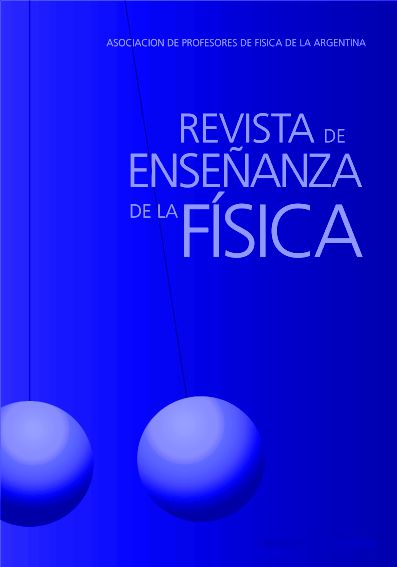La Realidad de los Átomos
DOI:
https://doi.org/10.55767/2451.6007.v27.n1.11409Palavras-chave:
Movimiento Browniano, Teoría cinética, Difusión, Fluctuación-disipaciónResumo
En este trabajo nos proponemos reconsiderar, desde una perspectiva histórica, la contribución de Albert Einstein a la de la teoría molecular de la realidad con sus trabajos sobre el movimiento Browniano.
Referências
Bachelier, L. (1900). Théorie de la speculation. Ann. Ecole Normale Superieure, 17 pp. 21–86.
Brown, R. (1828). A brief account of microscopical observations on the particles contained in the pollen of plants and the general existence of active molecules in organic and inorganic bodies. Edinburgh New Philosophical Journal, Jul-Sep pp. 358–371.
Einstein, A. (1905a). Über einen die Erzeugung und Verwandlung des Lichtes betreffenden heuristischen Gesichtspunkt. Ann. Physik, 17 pp. 132–148.
Einstein, A. (1905b). Zur Elektrodynamik bewegter Körper. Ann. Physik, 17 pp. 891–921.
Einstein, A. (1905c). Ist die Trägheit eines Körpers von seinem Energieinhalt abhängig? Ann. Physik, 18 pp. 639–641.
Einstein, A. (1905d). Über die von der molekularkinetischen theorie der Wärme geforderte Bewegung von in ruhenden Flüssigkeiten suspendierten Teilchen. Ann. Physik, 17 pp. 549–560.
Einstein, A. (1906a). Zur theorie der Brownschen bewegung. Ann. Physik, 19 pp. 371–381.
Einstein, A. (1906b). Eine neue Bestimmung der Moleküldimensionen. Ann. Physik, 19 pp. 289–306. Errata: Ann. Physik , 591–592 (1911).
Einstein, A. (1907). Theoretische bemerkungen über die Brownsche Bewegung. Z. Elektrochem., 13 pp. 41–42.
Einstein, A. (1908). Elementare Theorie der Brownschen Bewegung. Z. Elektrochem., 14 pp. 235–239.
Fick, J. (1855). Ueber diffusion. Ann. Physik, 170 pp. 59–86.
Haw, M.D. (2002). Colloidal suspensions, brownian motion, molecular reality: a short history. J. Phys.: Condens. Matter, 14 pp. 7769–7769.
Haw, M. D. (2005). Einstein’s random walk. Physics World, 18 pp. 19–22.
Hersh, R. y Griego, R.J. (1969). Brownian motion and potential theory. Sci. Am., March pp. 67–74.
Jarrow, R. y Proter, P. (2004). A short history of stochastic integration and mathematical finance: The early years, 1880–1970. In Anirban DasGupta, editor, A Festschrift for Herman Rubin, volume 45 of Lecture Notes - Monograph Series, pp. 75–91. Institute of Mathematical Statistics, Beachwood, Ohio, USA.
Langevin, P. (1908). Sur la théorie du mouvement brownien. C. R. Acad. Sci. Paris, 146 pp. 530–533.
Lord Rayleigh (1890). Measurements of the amount of oil necessary in order to check the motions of camphor upon water. Proc. Roy. Soc. London, 47 pp. 364–367.
Mahan, B. (1977). Química: Curso Universitario. Fondo Educativo Interamericano, 2da edición. Cap. 1.
Maxwell, J.C. (1873). On the final state of a system of molecules in motion subject to forces of any kind. Nature, 8 pp. 537–538.
Perrin, J. (1916). Atoms. D. van Nostrand, New York. Authorised translation by D. Ll. Hammick.
Reynols, O. (1853). An experimental investigation of the circumstances which determine whether the motion of water shall be direct or sinuous, and of the law of resistance in parallel channels. Phil. Trans. R. Soc. Lond., 174 pp. 935–982.
Stokes, G.G. (1951). On the effect of the internal friction of fluids on the motion of pendulums. Trans. Cambr. Phil. Soc., 9 pp. 8–106.
Svedberg, T. (1906). Über die Eigenbewegung der Teilchen in kolloidalen Lösungen. Z. Elektrochem., 12 pp. 853–860.
van der PAS, P. W. (1971). The discovery of the brownian motion. Scientiarum Historia, 13 pp. 27–35.
von Smoluchowski, M. (1906). Zur kinetischen Theorie der Brownschen Molekularbewegung und der Suspensionen. Ann. Phys., 21 pp. 757–779.
Downloads
Publicado
Edição
Seção
Licença
Copyright (c) 2015 Pedro Pury

Este trabalho está licenciado sob uma licença Creative Commons Attribution-NonCommercial-NoDerivatives 4.0 International License.
Aquellos autores/as que tengan publicaciones con esta revista, aceptan los términos siguientes:Los autores/as conservarán sus derechos de copiar y redistribuir el material, bajo los términos estipulados en la Licencia de reconocimiento, no comercial, sin obras derivadas de Creative Commons que permite a terceros compartir la obra bajo las siguientes condiciones:
- Reconocimiento — Debe reconocer adecuadamente la autoría, proporcionar un enlace a la licencia e indicar si se han realizado cambios. Puede hacerlo de cualquier manera razonable, pero no de una manera que sugiera que tiene el apoyo del licenciador o lo recibe por el uso que hace.
- NoComercial — No puede utilizar el material para una finalidad comercial.
- SinObraDerivada — Si remezcla, transforma o crea a partir del material, no puede difundir el material modificado.
- Los autores/as podrán adoptar otros acuerdos de licencia no exclusiva de distribución de la versión de la obra publicada (p. ej.: depositarla en un archivo telemático institucional o publicarla en un volumen monográfico) siempre que se indique la publicación inicial en esta revista.
- Se permite y recomienda a los autores/as difundir su obra a través de Internet (p. ej.: en archivos telemáticos institucionales o en su página web) antes y durante el proceso de envío, lo cual puede producir intercambios interesantes y aumentar las citas de la obra publicada. (Véase El efecto del acceso abierto).











